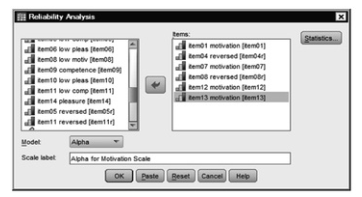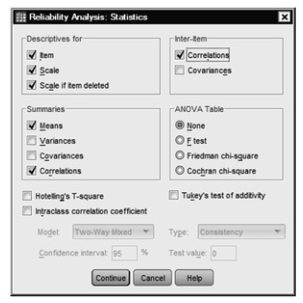The motivation score is composed of six items that were rated on four-point Likert scales, from very atypical (1) to very typical (4). Do the scores for these items go together (interrelate) well enough to add them together for future use as a composite variable labeled motivation?
- What is the internal consistency reliability of the math attitude scale that we labeled motivation?
Note that you do not use the computed motivation scale score. Instead, use the individual items to create the scale temporarily. Let’s do reliability analysis for the motivation scale.
- Click on Analyze →Scale → Reliability Analysis. You should get a dialog box like 3.1.
- Now move the variables item01, item04 reversed, item07, item08 reversed, item12, and item13 (the motivation questions) to the Items Be sure to use item04 reversed and item08 reversed (not item04 and item08) because a high rating on the original (unreversed) items indicates low motivation. The alpha will be based on the correlation among each pair of items, so they all need to be scored so that higher scores index the same thing (e.g., higher levels of motivation).
- Type Alpha for Motivation Scale in the Scale label box. Be sure the Model is Alpha (refer to Fig. 3.1).

Fig.3.1.Reliability analysis.
- Click on Statistics in the Reliability Analysis dialog box and you will see something similar to 3.2.
- Check the following items: Item, Scale, and Scale if item deleted (all under Descriptives for), Correlations (under Inter-Item), Means, and Correlations (under Summaries).
- Click on Continue then OK. Compare your syntax and output to Output3.1.

Fig.3.2. Reliability analysis: Statistics.
Source: Leech Nancy L. (2014), IBM SPSS for Intermediate Statistics, Routledge; 5th edition;
download Datasets and Materials.

19 Sep 2022
28 Mar 2023
27 Mar 2023
31 Mar 2023
31 Mar 2023
17 Sep 2022